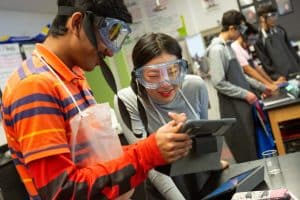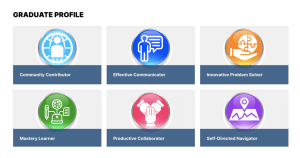Portrait of a Graduate: A Gateway to Competency-Based Learning
CompetencyWorks Blog
This blog post reviews the Next Generation Learning Challenge (NGLC)’s new resource, How Students Develop the Skills & Competencies in a Portrait of a Graduate. The resource highlights five school districts and their answer to the question: “How might we redesign teaching and learning to ensure all students have high-quality learning experiences that help them continuously develop the competencies in our Portrait of a Graduate?” We highlight elements from each of the five district’s Portrait of a Graduate (PoG) programs and their connection to competency-based education (CBE).
The Power of a Portrait of a Graduate
Advancing technology and our rapidly changing economy have widened the demand for skills and knowledge beyond the disciplinary knowledge that has been the foundation of our curriculum. Focusing solely on a narrow view of academic success no longer serves students. Learners need a broader vision of what their success could be that combines academic success with the essential skills and mindsets needed to navigate life.

A PoG design process can effectively build a new collective vision for student success. A strong design process involves all stakeholders in the educational community, including learners, teachers, parents, and the community. Whether it’s called a PoG – or a Graduate Profile, Portrait of a Learner, Habits of Success, or Lifelong Learning Standards – a PoG sets a vision for student learning and includes competencies, such as empathy and collaboration, that prepare them to thrive in all areas of life.
A PoG is a powerful tool and a natural entry point into CBE. CBE supports the design of a system that enables students to learn toward a broader vision of success. CBE provides the answer to how you can use a PoG in action to design high-quality, learner-centered experiences. Typically, a PoG includes competencies and CBE elements, such as student agency, that align with how competencies are envisioned in CBE. Designing a CBE system can bring the PoG to life to empower students to fulfill their potential.
Both CBE and the PoGs share similar principles for how students should learn within the education system. Aurora’s definition of CBE can be used as a framework to draw connections between the elements of CBE and PoGs, as illustrated with the following examples.
Students are empowered daily to make important decisions about their learning experiences, how they will create and apply knowledge, and how they will demonstrate their learning.
Kettle Moraine School District, located in Wales, WI, is home to a diverse community of schools organized under one Graduate Profile designed to fit each student’s current skills, experiences, and dispositions and best prepare them for their own future. The Kettle Moraine “Self-Directed and Resilient Learner” graduate profile component helps learners develop and demonstrate agency and ownership in their learning. This isn’t just a sign that hangs on the wall in the halls of Kettle Moraine; this is a real goal they are implementing within their schools. From kindergarten to senior year, students are given a voice and choices about how they want their learning experience to look. Whether a student is deciding which learning environment to enroll in, what they want their history project to look like, or what type of community outreach they want to commit to, students are demonstrating agency and self-direction.
KM Global, a charter school in Kettle Moraine focusing on global leadership and innovation, challenges students every day with this aspect of the graduate profile. Each semester, KM Global students develop an interdisciplinary inquiry project of their choice. Students do research, connect with field experts, and have discussions with their peers based on a topic of their interest and passion. Additionally, students choose the competencies they earn for their inquiry projects. They reflect on their learning thus far and consider: 1) where they’re at, 2) what they need, and 3) how they will get there.
Students progress based on evidence of mastery, not seat time.
The mission of Lindsay Unified School District (LUSD) in California is: Empowering and Motivating for Today and Tomorrow. In 2007, the district, the Lindsay community, and educators created the LUSD Strategic Design. The plan redefined student success to include and adopt a range of Lifelong Learning Standards, learner-centered practices, and performance-based systems. Their current approach includes CBE systems and practices with competencies such as personal well-being, interpersonal relationships, civic engagement, and cultural awareness.
LUSD transformed its system by implementing flexibility so that learning meets the student’s pace. Starting in elementary school, students cultivate mindsets for lifelong learning by demonstrating their learning beyond the classroom – whether at home, in the community, or through an extracurricular activity.
Students within LUSD do not fail or repeat grades and courses, like in traditional models. Instead, students who do not demonstrate mastery are supported in targeted ways. For example, if you were a learner who was “not yet ready to go on to level seven math and needed to meet three standards to move on, maybe you’ll do that Thursday night for the rest of the semester. Or maybe you’ll do that in a two-week boot camp if you need instruction. You don’t have to repeat the whole year. You just repeat the places you have holes in your learning. We know where those holes are, and you know where those holes are because Empower [their learning management system] is very clearly showing you.”
Additionally, students can access their curriculum 24/7 through the district’s learning management system. Executive director for curriculum and instruction, Cinnamon Scheufele, says that learners’ ability to “dig into content online” reinforces and builds student agency. Scheufele says the curriculum is designed so that students are exposed to multiple methods of learning content. She notes that “There’s more than one way to learn this content, and it doesn’t have to be from the adults.”
Students learn actively using different pathways and varied pacing.
Bullitt County Public Schools (BCPS) in Kentucky adopted the motto “Moving Forward” in an effort to build lifelong learners. In 2017, the district moved to transition its traditional learning structure to one that is learner-centered and empathizes with students. The district collaborated with stakeholders to develop a strategy that best supported students to succeed in school. Since launching in 2019, BCPS has shifted its focus to experiential learning through project-based learning and real-world tasks.
BCPS worked with their community to develop a graduate profile for their students. Their vision aims to empower students to have agency over how they want to demonstrate their learning. BCPS is transforming its assessment methods to include the student’s voice and to be more project-based and authentic.
For example, math teacher Kim Ludwig illustrates how project-based assessments can encourage active learning and elevate student voice. She assigned her students a project-based assessment to have them demonstrate what they learned in algebra. Ludwig asked her students to create their own rubrics and to include the criteria and how it will prove mastery of the material. Along with the rubric, students determined the due date of their project. Throughout the project, students could connect what they were learning – quadratics – to real-life situations. Ludwig identified that the project helped students find pathways to understand algebra’s abstract and complex concepts. The students thoroughly enjoyed the assignment, and a student from her class said, “When you can have fun with school, it helps me understand a lot better.”

Ludwig was a traditional teacher who had a traditional structure. She noticed that students were meeting the traditional standards and getting good grades but learning out of compliance. She reflected, “The graduate profile allows us to get to those kids who aren’t going to learn it out of compliance…You’ve got to have a hook for them. I found that when I started doing the projects, my kids were learning at a whole different level. It blew me away.”
Strategies to ensure equity for all students are embedded in the culture, structure, and pedagogy of schools and education systems.
Located in the Los Angeles Metropolitan Area, Da Vinci Schools is a public network of five schools and one college-and-career program that serves students from 122 different zip codes. Da Vinci Schools are focused on developing students with future-ready skills by combining academic and social-emotional learning in their Habits of the Heart and Mind and Graduate Profile. They want students to know who they want to be, where they want to go, and how to take on the world around them.
Equity must be the center of our work in CBE, and Da Vinci RISE is an excellent example of this. Da Vinci RISE was designed with and for youth experiencing homelessness, foster care, housing instability, the juvenile justice system, and transient populations. Due to many issues beyond students’ control, traditional requirements (like attendance requirements) kept students in the Da Vinci network from excelling in school. At Da Vinci RISE, students are not penalized for not being able to meet seat time requirements; they have flexible schedules and a credit recovery model. Therefore, students who need to be at home can be at home. Da Vinci RISE’s Graduate Profile includes five attributes: effective communicator, tactful collaborator, skilled problem-solver, critical thinker, and empowered citizen. This means that not only are students leaving with the content knowledge to be successful in their post-secondary careers, but also the skills and dispositions that will help them grow throughout the rest of their lives.
Da Vinci Connect, another school in the network that combines in-person and remote learning, uses the Habits and Hearts of Mind to shape their PoG, which includes empathy and equity. At Da Vinci Connect, they don’t just expect students to be empathetic and value equity; they model it for their students. Da Vinci Connect speaks openly about how 50% of what they teach is content, while the other 50% are skills like empathy and equity that will help prepare students for their future. Through their classroom structure, staff does their best to hold students accountable, have a high standard of work, embody a quality of intention, promote integrity, and encourage reflective thinking.
Rigorous, common expectations for learning (knowledge, skills, and dispositions) are explicit, transparent, measurable, and transferable.

Northern Cass School District in North Dakota is committed to providing students with important outcomes that ensure happiness and create fulfilled, engaged human beings. Co-created with students, NCSD embraces a Portrait of a Learner (PoL) that describes the skills, experiences, and dispositions each student will graduate with. These PoL competencies are assessed alongside knowledge content in a CBE environment, including accountability, communication, adaptability, learner’s mindset, and leadership.
In Northern Cass, administrators and teachers think interdisciplinarily about content mastery, skills, and dispositions. When creating lesson plans and curricula, NCSD educators must consider whether students demonstrate competence in academic content and PoL competencies. They assess both with equal weight and give intentional feedback around both. Staff deemphasizes scoring in the traditional sense and instead uses their role as educators to answer questions and work with individual students on their personal learning goals and needs.
In addition to coursework, students must create a capstone project by the end of their high school experience. There are two options for this: students can focus on one competency from the Portrait and highlight multiple activities in which they demonstrated it, or unpack a powerful learning experience (like an internship or meaningful school-based experience) and explore all of the PoL skills they developed and demonstrated. Because students are held to these rigorous expectations throughout their K-12 experience, NCSD has been able to implement this in smaller ways at the 3rd, 5th, and 8th-grade levels as well through portfolio presentations of work.
Conclusion
Aurora has long advocated for a PoG process as an entry point for states to encourage change and for districts to engage in making the shift to CBE. The new NGLC resource illustrates how districts are putting that work into action. We must think outside the box to ensure we properly prepare learners for life and post-secondary opportunities. We must forgo relying strictly on test scores and seat time to prove a student’s success. Developing a PoG is an intentional strategy that answers the question: What is student success, and how can we support students to be lifelong learners? It encompasses many factors that make a student successful outside of earning a letter grade, such as personal well-being and cultural awareness. It is an engaging vehicle for implementing and expanding CBE. The components of CBE provide an approach to build on the foundation of a PoG by allowing students to learn in a flexible, equitable, rigorous, and supportive environment. Both strategies fit together in the effort to reimagine learning to be more learner-centered and build lifelong learners.
Learn More
- Redefining Student Success: Organizing Education Systems Around the Knowledge and Skills Students Need to Succeed
- Teaching Portrait of a Graduate Skills
- CBE Starter Pack 7: Establish Rigorous, Common Expectations with Meaningful Competencies
 Khamiah Alderman joined the Aurora Institute as an intern with CompetencyWorks in January 2023. She is a recent Public Policy graduate from the University of North Carolina at Chapel Hill. She is passionate about educational equity and is working to better the education system for all learners, regardless of race, gender, religion, and ability.
Khamiah Alderman joined the Aurora Institute as an intern with CompetencyWorks in January 2023. She is a recent Public Policy graduate from the University of North Carolina at Chapel Hill. She is passionate about educational equity and is working to better the education system for all learners, regardless of race, gender, religion, and ability.
She currently serves as the Youth Program Manager for the Center for Racial Equity in Education in Charlotte, North Carolina. In this position, she is building a program dedicated to developing leaders who are informed and empowered to act locally at their schools and at the district level. In the past, Khamiah served as a research assistant for professors at UNC-Chapel Hill, where she gained valuable research experience grounded in education equity, intersectionality, and African-American history. She hopes to continue her work to transform the education system to be accessible for all.

Briana Medina joined the Aurora Institute as an intern with CompetencyWorks in May 2023. She is an alumna of Kettle Moraine School District and is currently a junior at the University of Wisconsin-Madison studying Political Science and Education Studies. She is committed to educational equity and passionate about its relation to competency-based learning.
She currently serves on the UW-Madison College of Letters and Science Curriculum Committee, where she reviews and recommends course and program additions, revisions, and policies relating to academic offerings. In the past, Briana has worked as an intern at Kettle Moraine School for Arts and Performance, giving tours and teaching in a competency-based learning environment. Additionally, she worked with the Institute for Personalized Learning panel discussions, high-level presentations, and blog posts.